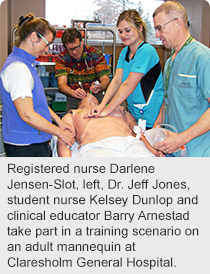
June 4, 2015
Story by Kerri Robins; Photo courtesy Lisa Kulas
 CLARESHOLM — You could say Claresholm General Hospital’s newest ‘patients’ are absolute dolls.
CLARESHOLM — You could say Claresholm General Hospital’s newest ‘patients’ are absolute dolls.
And you’d be correct — they’re high-tech medical mannequins used to practise scenarios.
“Our training mannequins help physicians, nursing staff and patients by providing training scenarios in a calm, safe and relaxed environment for staff,” says Barry Arnestad, clinical educator and developer of training events at the hospital.
“Not only are staff given the opportunity to practise their medical skills, but they can ask questions and learn new skills while getting used to what a real situation would be like.”
Thanks to funding through the Claresholm & District Health Foundation, the hospital bought two training mannequins last October: one adult male and one pediatric.
Costing about $6,500, the adult mannequin represents adults over age 18 and, aside from obstetrical issues such as a complicated birth, it’s used in training sessions for both sexes. The pediatric mannequin cost $4,500 and represents children ages 5 to 12.
Dr. Jeff Jones says he’s happy with the new opportunities the mannequins provide.
“The best way for our staff to respond calmly in emergency situations is to be well-trained so they feel confident providing the best possible diagnoses and treatment outcomes,” says Jones. “Training scenarios ultimately benefit our patients by helping us provide quality care gained by keeping our medical knowledge current.”
Health care staff work with Arnestad to determine where extra training is needed and then to customize an appropriate scenario. However, scenarios can also be random; staff know nothing of the session ahead of time.
“Cardiac arrests are common, so a lot of our training centres on scenarios such as heart attacks,” says Arnestad. “But we use our pediatric mannequins, as well, because children present with different vital signs such as lower blood pressure, higher pulse or a smaller airway.”
Technologically, these mannequins are no dummies. They resemble real patients, complete with vital signs such as blood pressure and heart rate.
Generally, a training event begins with a ‘patient’ with no pulse. The nurse, often first on the scene, calls the appropriate code. For example, a Code Blue indicates cardiac arrest — and the nurse will begin CPR. Staff and physicians quickly join in — using a heart monitor to record heart rate, pulse and breathing — to determine the diagnosis and subsequent treatment.
Arnestad can also use a monitor control device to make changes to the mannequin’s vital signs, mimicking what might happen in a real emergency. A drop in blood pressure, for example, can prompt staff to revise their diagnosis and treatment.
Training events are held once every two months, with two separate scenarios for groups of four to five. Since the mannequins arrived, four training events have been held.
“We have to keep our skills updated, especially with new knowledge and technology,” says Jones. “Holding a simulated hands-on emergency is far more beneficial than sitting in a classroom.”
Art Scott, Chair of the Claresholm & District Health Foundation, says he appreciates the value of these simulated emergencies.
“Our medical staffare able to continually practise their skills using simulations,” says Scott. “Our community is wonderful in helping us raise the funds needed to provide training mannequins.”
For more information, visit claresholmanddistricthealthfoundation.com